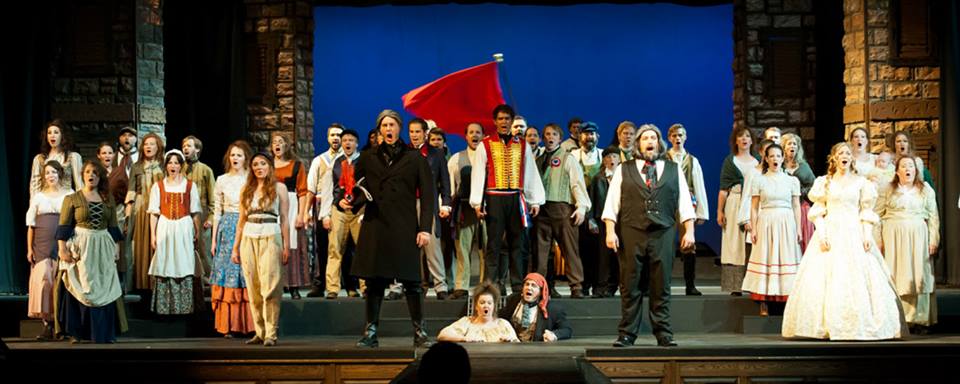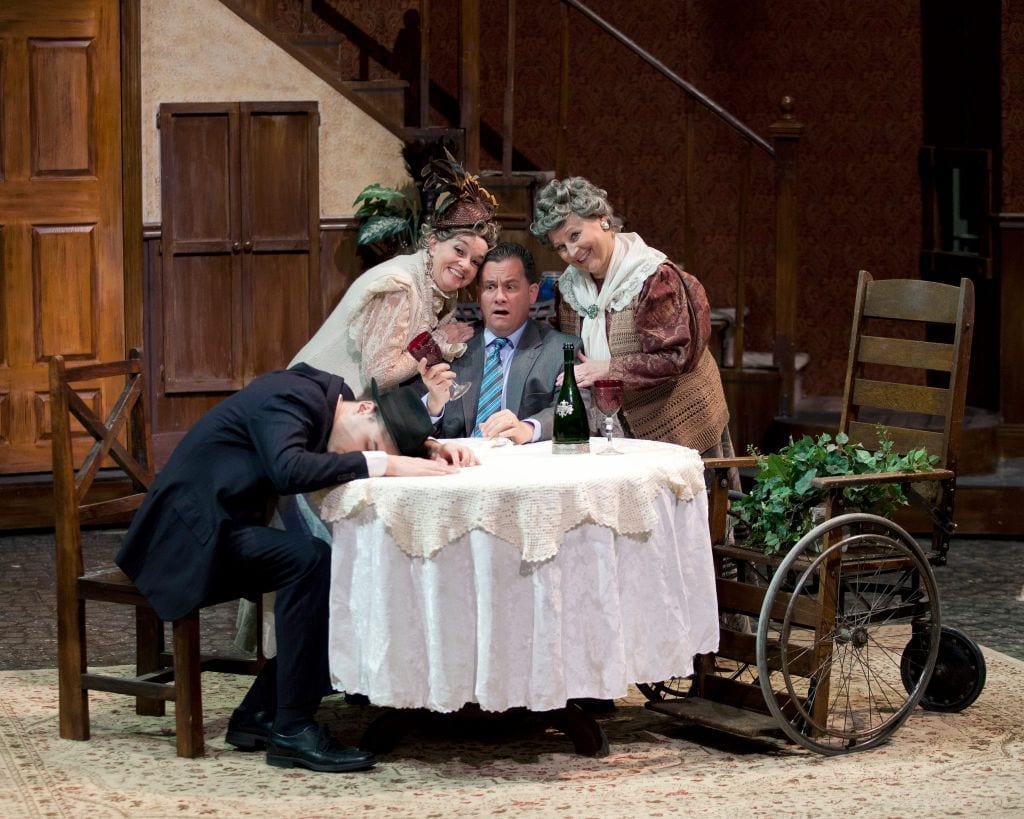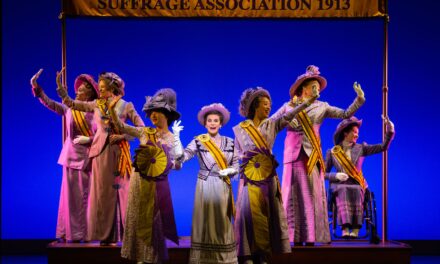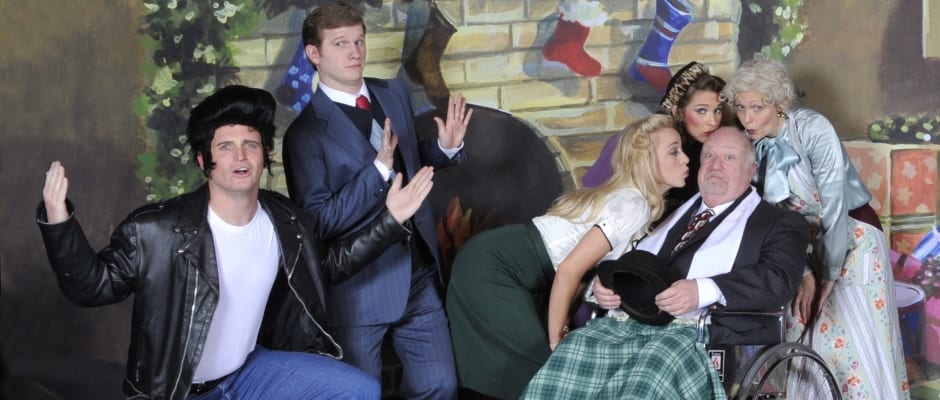PAYSON — From Victor Hugo‘s original tale comes the Payson Community Theater production of the classic Broadway adaptation of Les Misérables, playing through Labor Day at Payson High School. Convict Jean Valjean seeks to begin life anew, after serving a lengthy prison sentence. And though freedom looms ahead, he is reminded by rigid officer Javert that the weight of his law-breaking will always mark him as a lesser citizen. As Valjean goes forth to begin life anew, he is met with opposition at every corner and resorts to theft once more to secure a basic quality of life. But the merciful intervention of the Divine allows for Valjean to re-assess and become the man he always wanted to be. For a time, he is able to create a lifestyle resembling happiness, but encounters with the less fortunate of his peers reminds him that there is more of God’s work to be done, more souls in need of saving.
Valjean’s own story coincides with major social changes in France, and he finds himself irrevocably tied to the brave young men fighting against the government. His adopted daughter, Cosette, falls in love with one revolutionary in particular, Marius, and the two form a bond of utmost affection. Valjean’s identity is revealed to Javert, however, and any sense of comfort is dissolved as the officer begins his ardent task to find and bring Valjean to justice. Stories of love, longing, sacrifice, and rebellion thread in the operetta-style narrative and bring beautiful completion to the redemption story of Jean Valjean.
I was impressed with the rich vocal quality produced by the cast of this show. Musical director Justin Bills was able to coax a strength in tone from lead actors and ensemble alike, the result of which brought powerful fill to the auditorium. And while I did have some trouble understanding the lyrics themselves at times (more of a microphone problem than enunciation, however ) the caliber of tone itself was focused and full. Some of the volume levels for backtracks seemed a louder than necessary to the point where vocals were hard to distinguish at all, but this varied from song to song. But I could have listened to Javert (Scott Johnson) and Jean Valjean (Steve Dunford) all night. Their voices were clear, powerful, and a strong point of anchor for this production. Overall, the balance was pleasing, and the cast did justice to Claude-Michel Schönberg‘s music.
Physically, the pictures created on stage were pleasing enough to see. With such a large ensemble it could have easily devolved into chaos, but directors Michael and Colleen Carrasco controlled the large numbers and created nice stage pictures in every scene. I had a fun time watching the ensemble in this piece, watching the little side-moments and seeing the deliberation of their choices. It made for a very visually textured performance, and never left me without some little nuance to enjoy.
The set itself (designed by Michael Carrasco) created a traditional feel to performance, with its designs of a pictorial French town, for example. I wasn’t entirely a fan of some of the special effects used, simply because they felt overused. The rotating piece of stage, for example, worked very well for showing scenes when two opposing characters needed to have voices shown, but at times the speed didn’t necessarily suit the tempo of music, and felt like use of technology for the sake of technology. Rather than suiting a natural integration with the progression of plot, it felt like Payson was showing off. In comparison, the use of a silhouetted backdrop to show progression of time worked to great effect, and suited the more theatrical feel of the show.
Costumes (designed by Colleen Carrasco) were a point of mixed, though. Many of the main costumes suited a more period feel and created a nice atmosphere for the texture of the show. Things felt very theatrical throughout the evening, and rather than existing in a historical time period, I was often reminded that I was watching a show. Some wig lines, for example, were highly visible, though they were not distracting. And while a few of the pieces didn’t fit into the period of the play, they did not detract from the overall action.
One choice that did detract from the performance was a notably choreographed feel to the entirety of the night’s performance. With such rich vocal quality and beautiful voices filling the auditorium, I had hoped for an equally emotional and stunning acting performance. Many actors, however, seemed to perform in a highly caricatured plane of human emotion, and the effect felt campy and overtly theatrical. The narrative and emotions are so blatantly laid out in the lyrics (by Alain Boubil, Jean-Marc Natel, and Herbert Kretzmer), and for the directors to use gesticulation to “tell the story” more than the words themselves was problematic. This was most noticeable in the role of Fantine (played by Kirsten Quist) who, despite an absolutely stunning voice, suffered from a lack of conviction in her tribulation. Everything felt like a parody of her emotional trials, if only because the acting itself felt highly choreographed. I don’t quite think that beautiful voices were enough to balance out the campy feel of acting, and that more trust placed in the hands of viewers would have lent to a sharper production.
However, this directing style worked for Monsieur Thénardier (played by David Aintablian). His exaggerated gesticulation and facial expressions absolutely suited the seedy nature of his character. It suited the role, and so portrayal felt more natural and fun. But when this same magnification applied to others, some of the emotional depth of the play was lost. I could see real emotion struggling behind imposed movement, and it was disappointing to see actor instincts suppressed for the sake of unnecessary choreography. I could, in closing my eyes, gather more heart and soul than in glancing over the stage.
I greatly appreciated the careful balance of beautiful voice and command of performance demonstrated by Marius (played by Paul Cave), Enjolras (played by Colton Simons), and Cosette (played by Amy Rachel Paulson). The three played gave their archetypal characters a human nature, and their vocal performances felt so innate. Chemistry—romantic or platonic—resonated in their performances and I greatly enjoyed those moments when they were on stage. The scenes involving Les Amis d’ABC brought a prominent feel of cohesion and unification of voice and body that was both provoking and exciting to watch.
Yet, I am surely impressed with the attendance at this production. I’ve seen community theater suffer from attendance in many areas, and this show was absolutely packed to the brim with eager theater-goers. It is exciting to see a city that can cultivate a fixture of theater in the community, and inspire so many people to come and partake in the offering of performance. And as far as community theater goes, this really was a high-calibre of performance. A packed house and standing ovation on opening night surely goes to show just how effective this show was in the place of Payson community. It remarkably refreshing to see so many people lending avid support to community theater. I think with a bit more trust in the audience’s ability to follow the narrative, and with more trust in the actors to deliver the narrative, this production of Les Misérables could have been even better. But it is still definitely a charming night of theater, and I was not disappointed.










